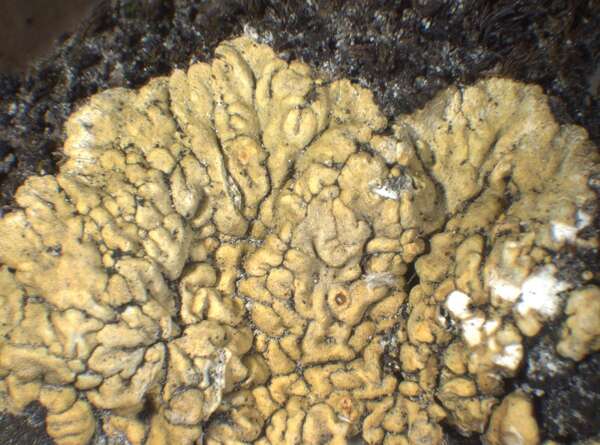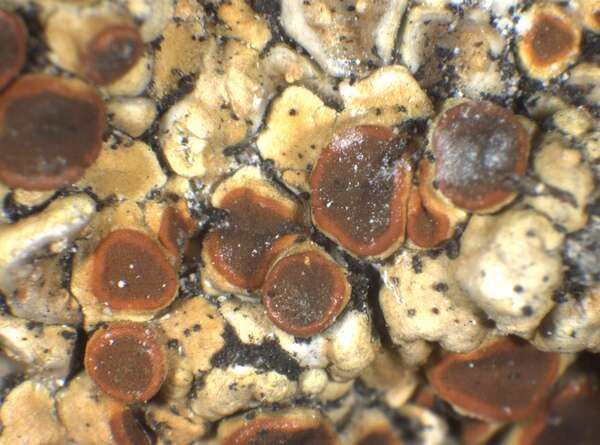Gyalolechia pruinosa Körb.
Ver. zool.-bot. Ges. Wien, 17: 703, 1867.
Synonyms: Caloplaca aurea f. rupicola (Arnold) Zahlbr.; Caloplaca pruinosa (Körb.) Zahlbr.; Candelariopsis pruinosa (Körb.) Szatala; Fulgensia pruinosa (Körb.) Poelt; Fulgensia pruinosa var. fissiseda Poelt
Description: Thallus crustose-placodioid, episubstratic, whitish yellow to orange-yellow, white-pruinose in central parts, forming 1-2 cm wide rosettes. Areoles 1-2(-3) mm broad, flattened, contiguous, the marginal ones distinctly elongate, forming 2-3 mm wide, radiating, contiguous lobes, anchored to thin layers of soil in rock fissures by rhizine-like bundles of hyphae. Apothecia frequent, numerous, zeorine, rounded, sessile, 0.5-1(-2) mm across, with a reddish orange to brownish orange, flat, rugose disc and a thin, orange-yellow, pruinose margin. Epithecium brownish orange, K+ purple-red; hymenium colourless, 70-80 μm high; hypothecium colourless. Asci 8-spored, clavate, functionally unitunicate, apically thickened with a broad internal beak, the inner part of apex and external cap I+ blue, Teloschistes-type. Ascospores 1-septate, hyaline, fusiform, thin-walled, 18-27(-30) x 5-8 μm, often slightly constricted at septum. Pycnidia orange-yellow, immersed. Conidia narrowly ellipsoid. Photobiont chlorococcoid. Spot tests: thallus and apothecia K+ purple-red, C-, KC-, P-, UV+ pale orange. Chemistry: fragilin dominant, with smaller amounts of emodin and parietin.
Growth form: Crustose
Substrata: rocks
Photobiont: green algae other than Trentepohlia
Reproductive strategy: mainly sexual
In underhangs rarely wetted by rain
Commonnes-rarity: (info)
Alpine belt: rare
Subalpine belt: very rare
Montane belt: absent
Dry submediterranean belt: absent
Humid submediterranean belt: absent
Padanian area: absent
pH of the substrata:
1 2 3 4 5
Solar irradiation:
1 2 3 4 5
Aridity:
1 2 3 4 5
Eutrophication:
1 2 3 4 5
Poleotolerance:
0 1 2 3
Altitudinal distribution:
1 2 3 4 5 6
Rarity
absent
extremely rare
very rare
rare
rather rare
rather common
common
very common
extremely common
Loading data...
Occurrence data
Predictive map
Growth form: Crustose
Substrata: rocks
Photobiont: green algae other than Trentepohlia
Reproductive strategy: mainly sexual
In underhangs rarely wetted by rain
Commonnes-rarity: (info)
Alpine belt: rare
Subalpine belt: very rare
Montane belt: absent
Dry submediterranean belt: absent
Humid submediterranean belt: absent
Padanian area: absent
pH of the substrata:
| 1 | 2 | 3 | 4 | 5 |
Solar irradiation:
| 1 | 2 | 3 | 4 | 5 |
Aridity:
| 1 | 2 | 3 | 4 | 5 |
Eutrophication:
| 1 | 2 | 3 | 4 | 5 |
Poleotolerance:
| 0 | 1 | 2 | 3 |
Altitudinal distribution:
| 1 | 2 | 3 | 4 | 5 | 6 |
Rarity
absent
extremely rare
very rare
rare
rather rare
rather common
common
very common
extremely common
Loading data...
Occurrence data
Predictive map








